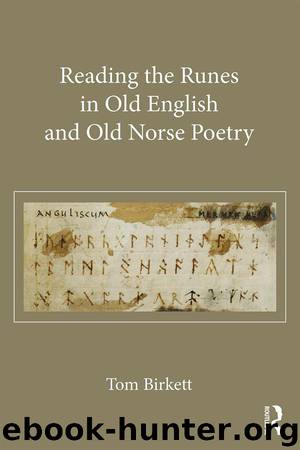Reading the Runes in Old English and Old Norse Poetry by Birkett Thomas

Author:Birkett, Thomas [Birkett, Thomas]
Language: eng
Format: azw3
ISBN: 9781472446268
Publisher: Taylor and Francis
Published: 2017-03-26T16:00:00+00:00
Conclusion
As Halsall points out, ‘much of the effect of any Old English poem containing runes depends upon the distinctive appearance of the rune symbols in contrast to the ordinary insular script on a manuscript page’,127 the script defined against the logos of the roman body text. As well as ensuring the script retained some value for display purposes, the distinctiveness of runes may also have introduced a visual disconnect within a text of ‘regularly formed characters lined up like bricks in a wall’128 that helped to turn the display features of the script into something more productive. The visual imprint (or physical presence) of runes in Solomon and Saturn I and the rune poems seems to have inculcated a heightened attention to the texture, appearance and material context of the written word, and indeed the structure of the written text. In Solomon and Saturn I the ornate runes become the visual correlative to the representation of personified letters, and knowledge of the runic tradition may even have influenced the central poetic conceit of hypostatising the Pater Noster prayer and depicting it as ‘palm-twigged’. In the OE Rune Poem not only do the written characters serve as the visual locus for each riddlic stanza, but in certain cases influence the poetic description of the rune name. Furthermore, the structure of the fuþorc appears to have inspired the poet to experiment with the manipulation of textual space, including varying stanza length to spatially encode the ættir divisions. In the Norwegian Rune Poem a connection between form and literary content can be traced even more clearly, several stanzas alluding directly to the shape of the rune on the page. The runes in these poems are examples, I would argue, of what Eagleton refers to as Barthes’s ‘double’ sign, a signifier ‘which gestures to its own material existence at the same time as it conveys a meaning’.129 By doing so, it focuses attention on the word, and the text, as a physical entity.
Neither the Icelandic rune poem, best characterised as a ‘rhetorical lexicon’,130 nor the earliest surviving witness to a rune poem tradition, the Abecedarium Nordmannicum, demonstrate any clear attention to the form of the written characters. In the case of the Icelandic tradition on the one hand, the rune names are preserved in the context of a culture of skald-craft, and the fuþark provided a convenient list for a poet (or poets) to exercise their erudition and trot out a list of kennings relating to the name.131 The runes themselves might as well be invisible. The Abecedarium Nordmannicum, on the other hand, is a short piece of mnemonic verse found in a ninth-century manuscript composed in an admixture of Low and High German, and probably originating from a missionary school at Fulda.132 It thus treats the fuþark from a distance, and as Halsall points out ‘there is no significant resemblance between this inept alliterative jingle and any of the other three rune poems’.133
However, in a chapter so closely concerned with the ornamental value
Download
This site does not store any files on its server. We only index and link to content provided by other sites. Please contact the content providers to delete copyright contents if any and email us, we'll remove relevant links or contents immediately.
| African | Asian |
| Australia & Oceania | Canadian |
| Caribbean & Latin American | European |
| Middle Eastern | Russian |
| United States |
The Universe of Us by Lang Leav(15006)
The Sun and Her Flowers by Rupi Kaur(14446)
Adultolescence by Gabbie Hanna(8857)
Whiskey Words & a Shovel II by r.h. Sin(7956)
Love Her Wild by Atticus(7700)
Smoke & Mirrors by Michael Faudet(6130)
Wiseguy by Nicholas Pileggi(5671)
The Princess Saves Herself in This One by Amanda Lovelace(4911)
Love & Misadventure by Lang Leav(4794)
Memories by Lang Leav(4749)
Milk and Honey by Rupi Kaur(4697)
Bluets by Maggie Nelson(4473)
Too Much and Not the Mood by Durga Chew-Bose(4272)
Pillow Thoughts by Courtney Peppernell(4208)
Good morning to Goodnight by Eleni Kaur(4190)
The Poetry of Pablo Neruda by Pablo Neruda(4038)
Algedonic by r.h. Sin(4011)
HER II by Pierre Alex Jeanty(3563)
Stuff I've Been Feeling Lately by Alicia Cook(3406)
